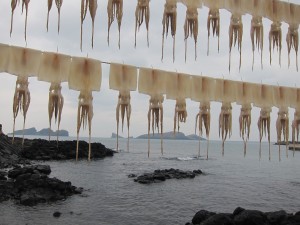The Origin of Neolithic Culture in Jeju Islands, Korea
Combining experts in multiple disciplines, Dr. Lee and her team are searching for new insights into the earliest settlers of Jeju Island, who made the earliest pottery found anywhere in Korea. This project will re-excavate the site of Gosanri (or Kosan-ri, Historic Sites of South Korea No. 412, 98,456 km2) on the west coast of Jeju Island, 120 km off the south coast of the Korean Peninsula, in order to understand the emerging Neolithic culture in Jeju and its relationship to the Terminal Paleolithic in a broad East Asian perspective.
Jeju can provide unique insights into several important anthropological questions, including peopling, island adaptations, cultural interactions over the oceans, and the possibility of independent pathways to Neolithization. Until 15,000 BP, the sea level on the Korean southern sea shelf was 150–160 m lower than the present, connecting Jeju to the Korean Peninsula and forming a land bridge between the Peninsula and Kyushu. By 10,000 BP, however, Jeju was separated from the Peninsula, although the two were much closer than today, with a shallower body of water to cross (Lee et al. 2008). The landbridge is often viewed as facilitating the peopling of Jeju during the Late Pleistocene, with the lack of the Terminal Paleolithic sites on Jeju resulting from subsequent sea-level rise (Shin 2011). We will interrogate this hypothesis in light of developments in the early Holocene.
The team is investigating the Neolithic culture of Jeju’s stone tool assemblages. fiber-tempered pottery, settlement landscape, broad-spectrum economy, and the responsiveness of people to environmental changes, while actively changing the environment themselves. Jeju can offer an excellent case study on archaeological islander behaviors, considering the long-term habitation from the Early Holocene, cultural niche construction of diverse inhabitable landscapes, and proximity to both the Korean Peninsula and Kyushu Islands of Japan.


